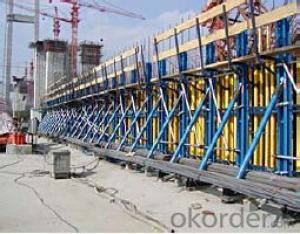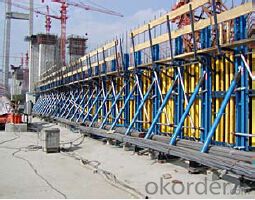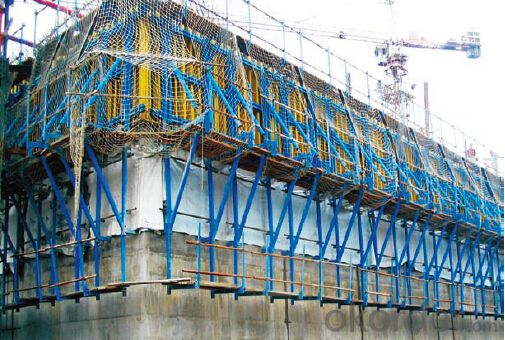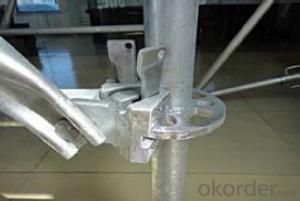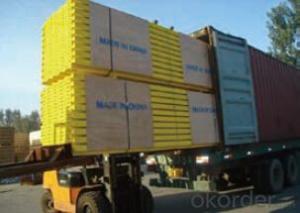Single-Side Climbing Bracket for formwork and scaffolding systems
- Loading Port:
- Tianjin
- Payment Terms:
- TT OR LC
- Min Order Qty:
- 50 m²
- Supply Capability:
- 1000 m²/month
OKorder Service Pledge
OKorder Financial Service
You Might Also Like
Single-side Climbing Bracket SCB180:
With CNBM SCB 180 climbing systems, the loads from the fresh concrete pressure are
transferred through the brackets by means of V-strongbacks and compression braces into the
scaffold anchors.
Typical applications for the SCB 180 are dams, locks, cooling towers, pier heads, tunnels, and
bank vaults.
The formwork is simply tilted backwards when striking takes place. The 1.80 m wide bracket
requires only a minimum of space.
Characteristics:
◆ Economical and safe anchoring
The M30/D20 climbing cones have been designed especially for single-sided concreting using
SCB180 in dam construction, and to allow the transfer of high tensile and shear forces into the still
fresh, unreinforced concrete. Without wall-through tie-rods, finished concrete is perfect.
◆ Stable and cost-effective for high loads
generous bracket spacings allow large-area formwork units with optimal utilization of the bearing
capacity. This leads to extremely economical solutions.
◆ Simple and flexible planning
With SCB180 single-sided climbing formwork, circular structures can also be concreted without
undergoing any large planning process. Even use on inclined walls is feasible without any special
measures because additional concrete loads or lifting forces can be safely transferred into the
structure.
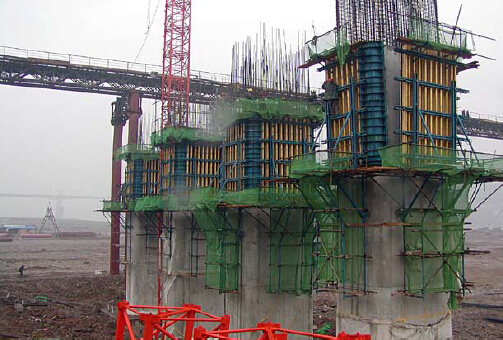
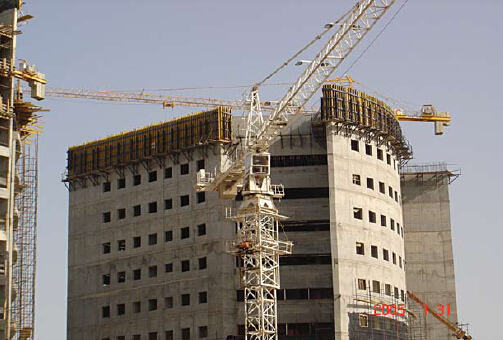
- Q: Can steel formwork be used for both small and large-scale construction projects?
- Yes, steel formwork can be used for both small and large-scale construction projects. Steel formwork is highly versatile and can be easily customized to meet the specific requirements of different project sizes. It offers strength, durability, and stability, making it suitable for various construction applications, ranging from small residential buildings to large commercial structures.
- Q: Can steel formwork be used for both above-water and underwater structures?
- Steel formwork can be utilized for both structures above the water surface and those submerged underwater. Its strength and durability have earned it a reputation suitable for a wide range of construction projects. When employed for structures above the water, steel formwork acts as a robust and dependable support system for casting concrete, guaranteeing the desired shape and finish are achieved. Furthermore, steel formwork is commonly employed for underwater structures due to its ability to endure the harsh conditions and pressures associated with submersion. It is engineered to be watertight and resistant to corrosion, enabling its use in casting concrete underwater. This ensures the concrete is shaped and cured correctly, resulting in structurally sound underwater constructions. In addition to its strength and durability, steel formwork also provides several advantages for both structures above the water and underwater. It is reusable, reducing construction costs and minimizing environmental impact. Moreover, steel formwork is versatile, accommodating flexible designs and adapting to diverse project requirements. Nevertheless, it is crucial to consider the specific requirements and conditions of each project when determining the suitability of steel formwork for a particular application. Factors such as water pressure, water quality, and the presence of corrosive substances should be carefully evaluated to ensure the longevity and effectiveness of the steel formwork in both structures above the water and underwater.
- Q: What are the different types of formwork release oils used with steel formwork?
- There are typically two types of formwork release oils used with steel formwork: petroleum-based oils and water-based oils. Petroleum-based oils provide excellent adhesion and protection against rust, but they can be flammable and may have a strong odor. Water-based oils, on the other hand, are non-flammable and have a low odor, making them more environmentally friendly. However, they may not provide the same level of adhesion and rust protection as petroleum-based oils.
- Q: How does steel formwork help in achieving a high-quality finish?
- Steel formwork helps in achieving a high-quality finish due to its ability to provide a strong and rigid structure for concrete placement. Its smooth and non-absorbent surface prevents the formation of air bubbles, resulting in a smooth and even finish. Additionally, steel formwork allows for precise and accurate shaping and alignment, ensuring the desired dimensions and contours of the final concrete product.
- Q: How does steel formwork handle concrete finishing and curing agents?
- Steel formwork is a highly durable and versatile material that is specifically designed to handle the concrete finishing and curing process. Due to its strength and rigidity, steel formwork provides a stable structure that ensures the concrete is poured and cured in a controlled manner. During the concrete finishing stage, steel formwork allows for the smooth and even application of various finishing agents such as troweling, brushing, or spraying. The smooth surface of steel formwork allows for the easy application and manipulation of these agents, resulting in a uniform and aesthetically pleasing finish. Additionally, steel formwork is resistant to chemical reactions with concrete curing agents. Concrete curing agents are applied to the surface of freshly poured concrete to enhance its strength, durability, and appearance. These agents can include sealers, curing compounds, or coatings. Steel formwork does not chemically react with these substances, ensuring that they can be applied and absorbed by the concrete without any negative effects on the formwork material. Moreover, steel formwork is non-absorbent, meaning it does not absorb any moisture from the curing agents or the concrete itself. This characteristic is crucial during the curing process as it allows the concrete to retain its moisture content, ensuring proper hydration and strength development. The non-absorbent nature of steel formwork also prevents any potential damage or degradation that could occur if the formwork material were to absorb moisture and expand or corrode. In summary, steel formwork is an ideal material for handling concrete finishing and curing agents due to its strength, rigidity, non-reactive nature, and non-absorbent properties. It provides a stable structure for the application of finishing agents, while also allowing for proper curing and moisture retention in the concrete.
- Q: How does steel formwork contribute to the overall energy efficiency of the building?
- There are several ways in which steel formwork contributes to the overall energy efficiency of a building. Firstly, its high durability and long lifespan mean that it can be reused multiple times for different construction projects. This reduces the need for new formwork materials, which in turn decreases the energy and resources required for manufacturing and transportation. Moreover, steel formwork allows for more precise and accurate construction, resulting in tighter and better-insulated structures. This improved insulation helps to minimize heat transfer and air leakage, thus reducing energy consumption for heating and cooling. The solid and airtight barrier created by steel formwork contributes to a more energy-efficient building envelope. Additionally, the use of steel formwork enables the construction of complex shapes and designs, giving architects the opportunity to incorporate energy-efficient features such as passive solar heating, natural ventilation, and daylighting strategies. These design elements can greatly reduce the reliance on artificial lighting, heating, and cooling systems, further enhancing the overall energy efficiency of the building. Finally, steel formwork is often combined with other sustainable building materials, such as recycled steel or eco-friendly concrete mixtures. This combination of materials enhances the overall sustainability of the construction process and reduces the environmental impact associated with traditional formwork materials. In conclusion, steel formwork contributes to the overall energy efficiency of a building through its durability, precision construction, ability to support energy-efficient designs, and use of sustainable materials. By incorporating steel formwork into construction projects, builders can help create more energy-efficient buildings, reducing their environmental footprint and promoting sustainable development.
- Q: I would like to ask, large steel formwork and the average number of square meters of a template?
- Need to find a professional person to look at the drawings, the decision to hire how much, so generally speaking, and different geographical, who is difficult to give you the answer,
- Q: How does steel formwork affect the overall maintenance requirements of the structure?
- Steel formwork can have a significant impact on the overall maintenance requirements of a structure. One of the major advantages of using steel formwork is its durability and long lifespan. Unlike traditional timber formwork, steel formwork is more resistant to wear and tear, weather conditions, and insect infestation. This means that the structure built using steel formwork will require less maintenance over time. Additionally, steel formwork provides a smooth and even surface finish, reducing the need for extensive repair and maintenance work. This is especially important for structures that require a high level of accuracy and precision, such as tall buildings or bridges. The use of steel formwork ensures that the structure is built with minimal imperfections, reducing the need for costly and time-consuming maintenance in the future. Furthermore, steel formwork is designed to be reusable, which can significantly reduce maintenance costs. After the concrete has set, the steel formwork can be easily dismantled and used for other construction projects. This not only saves money but also reduces waste, making steel formwork a more sustainable option. However, it is important to note that steel formwork requires proper cleaning and maintenance after each use to ensure its effectiveness and longevity. Regular inspections and maintenance checks should be conducted to identify any signs of damage or deterioration. Any repairs or replacements should be carried out promptly to prevent further issues. In summary, the use of steel formwork can greatly reduce the overall maintenance requirements of a structure. Its durability, resistance to damage, and reusability make it a cost-effective and low-maintenance option. However, proper cleaning, maintenance, and periodic inspections are still necessary to ensure its optimal performance and longevity.
- Q: How does steel formwork affect the overall aesthetics of a construction project?
- The overall aesthetics of a construction project can be significantly influenced by steel formwork. Unlike traditional timber formwork, steel formwork offers a modern and sleek look that enhances the visual appeal of a structure. The clean lines and smooth surfaces achieved with steel formwork give a building a polished and sophisticated appearance. Moreover, steel formwork allows for greater precision and accuracy in shaping concrete, resulting in a more seamless and uniform finish. This is particularly important in architectural designs that require intricate or complex shapes. By using steel formwork, the concrete is poured exactly as intended, resulting in a more visually appealing end result. Furthermore, steel formwork is highly durable and resistant to wear and tear. It does not warp or deform over time, maintaining its structural integrity and aesthetic appeal for a longer period. This durability contributes to the longevity and overall quality of a construction project, making it a more attractive investment for owners and potential buyers. Another advantage of steel formwork is its adaptability. Steel can be easily molded and shaped into various sizes and configurations, allowing for greater design flexibility. This versatility empowers architects and designers to create unique and eye-catching structures that stand out from the rest. In conclusion, the use of steel formwork in a construction project has a positive impact on its overall aesthetics. Its sleek appearance, precise shaping capabilities, durability, and design flexibility all contribute to a visually appealing end result. Steel formwork enhances the architectural design, creates a polished finish, and increases the longevity and value of the structure.
- Q: Can steel formwork be easily transported to different construction sites?
- Yes, steel formwork can be easily transported to different construction sites. Steel formwork is known for its durability and strength, which allows it to withstand the rigors of transportation without any significant damage. Additionally, steel formwork can be dismantled and reassembled easily, making it highly portable. This feature enables construction companies to reuse the formwork at multiple sites, reducing the need for new materials and saving costs. The versatility and ease of transportation of steel formwork make it a popular choice among contractors for various construction projects.
Send your message to us
Single-Side Climbing Bracket for formwork and scaffolding systems
- Loading Port:
- Tianjin
- Payment Terms:
- TT OR LC
- Min Order Qty:
- 50 m²
- Supply Capability:
- 1000 m²/month
OKorder Service Pledge
OKorder Financial Service
Similar products
Hot products
Hot Searches
